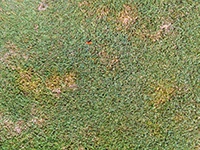
Dr. Bruce Clarke, Director of the Center for Turfgrass Science at Rutgers University, has been a part of a research group at Rutgers focused on anthracnose. The results from the 14-year long research project reveal how anthracnose can be thwarted through better management practices.
What are the signs that indicate anthracnose that superintendents should be looking for?
First of all, there are two different types of anthracnose; Foliar Blight and Basal Rot. Foliar Blight turns the foliage yellow. Most superintendents know what signs to look for because they’re unusual and easy to notice. Basal Rot is a stem rot. Which, when on the main stem it kills the plant. They are concerned about the Basal Rot anthracnose more so than the Foliar Blight. The difference between the two is that the Basal Rot is on the stem.
What are the conditions that help anthracnose thrive?
What are the trends in research on anthracnose right now?
The project we are finishing up on started in 2001 when the disease was running rapidly on golf courses. We started as a research project and in 2005 expanded to a universal research project within 11 universities. Including one in Guelph, Canada. Right now we are focusing on putting together results from previous research about the best program for superintendents. They can reduce fungicide use by 80 percent if they utilize the best management process from this project. If we just understand how golf course superintendents are combating anthracnose and combine the various ways we can figure out the best management process.
What should superintendents do to fight it?
Superintendents need to change their management practices. When it comes to mowing, superintendents can significantly reduce anthracnose while still maintaining green speed. They have to increase the height of cut and increase mowing frequency and initiating frequent lightweight rolling. Nitrogen fertility also has a great effect on fighting anthracnose. Applying 0.1 lb. per 1,000 sq. ft. per week starting in the late spring and through the summer reduces anthracnose more than applying every month. Research also shows that both fall and spring applications of topdressing reduce anthracnose severity. But, spring topdressing is more beneficial of the two. The bottom line is increase mowing heights, increase fertility, decrease drought stress and proper topdressing.
For more information of Rutgers anthracnose research visit http://turf.rutgers.edu/
Get curated news on YOUR industry.
Enter your email to receive our newsletters.Latest from Golf Course Industry
- Carolinas GCSA raises nearly $300,000 for research
- Advanced Turf Solutions’ Scott Lund expands role
- South Carolina’s Tidewater Golf Club completes renovation project
- SePRO to host webinar on plant growth regulators
- Turfco introduces riding applicator
- From the publisher’s pen: The golf guilt trip
- Bob Farren lands Carolinas GCSA highest honor
- Architect Brian Curley breaks ground on new First Tee venue





